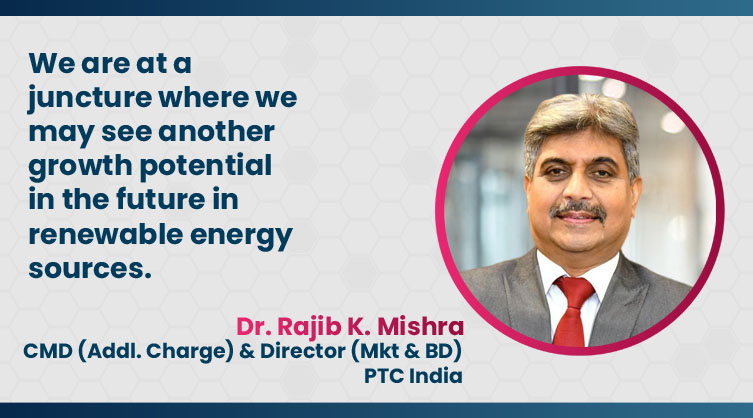PTC sets a target of 500MW of renewable additions
By Admin November 16, 2022 12:00 pm IST
By Admin November 16, 2022 12:00 pm IST

PTC’s vision is to be a frontrunner in power trading by developing a vibrant power market and striving to correct market distortions, says Dr. Rajib K. Mishra, CMD (Addl. Charge) & Director (Mkt & BD) of PTC India.
How do you assess the effects of the current energy transition on power trading?
PTC is transitioning to renewable energy along with all other Indian energy sector participants. Our focus is not only to increase the proportion of RE in the pool of tradable surplus but also to contribute to the balancing market required to address the inherent intermittency of RE. The purpose is that, as RE is available in some parts in the form of wind or solar, we need to ensure that the power supply to the consumers is 24*7. As we supply a larger quantum of RE in the market. PTC is making all these efforts to provide the balance. Also, the profile of customers should be taken care of while transitioning to RE. As a fundamental principle, the variability in demand or supply is an opportunity in trading to address mismatches. We want to offer this balancing supply to the customer for any industry.
Can you give us an update on the current state of the power markets?
India is the third largest producer and electricity user in the world. We have a total generation of almost 1400 TWh and an installed capacity exceeding 400 GW. We have these vast capacities, but our per capita consumption is low compared to developing countries like Brazil or any other European nation. There is a significant opportunity for growth for us, and with a GDP growth expected to be 7-7.5 percent in the future, there is a huge demand for electricity in the market. Of course, we must keep in mind that we have a target of 500 MW of renewable capacity addition. We are also moving towards hydrogen as a fuel source. Then EVs are also being considered an alternate mode of transportation, so many things are encouraging. We are at a juncture where we may see another growth potential in the future. India has played a pivotal role in reviving the regional power market in South Asia. The economic policies and structural developments have introduced possibilities for comprehensive regional integration. Bilateral energy trade between India and its neighbours is a crucial building block of the integrated regional energy market. PTC is the pioneer in crossborder trading with Bangladesh, Nepal and Bhutan. Additionally, we are closely monitoring the situation and would like to increase the business we currently conduct with these nations. The new power laws and policies, such as the general network access GNA, green open access, and the payment settlement mechanism, as well as the ancillary services regulations and late fees, are some of the other significant things that have recently occurred in the supply segment, which has advanced the market design and which is becoming more mature.
How is the ever-increasing energy demand changing the power market and trading prices?
A complicated interplay between supply and demand variables leads to trading prices. In addition to being influenced by supply and demand, the trading market and market prices are also affected by global concerns, such as fuel supply, given the geopolitical environment. At this point, it is essential to highlight that the overall short-term trading, whether through exchanges or simply bilaterally is eight to ten percent of the country’s total generation, has recently changed and undergone a significant transition throughout the COVID period. When the country’s demand was just 180 to 190 GW, it increased to 200 to 210 GW at its peak, an increase of approximately 11 percent over the previous six months. We must pay special attention to how the demand is developing. And, of course, we have to keep an eye on commodity inflation that is reflected in energy prices such as natural gas and imported coal and the impact on the cost of electricity. In the long run, the demand for a massive capacity of the VRE, new elements like storage and evolving market design, trading activities, value added services, and market aggregation is likely to increase. We are also witnessing a significant shift in the use of hydrogen as a fuel.

We use cookies to personalize your experience. By continuing to visit this website you agree to our Terms & Conditions, Privacy Policy and Cookie Policy.